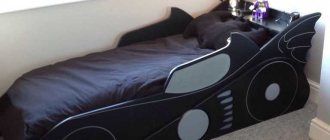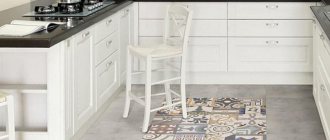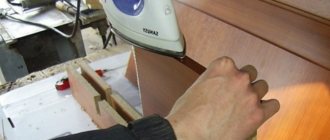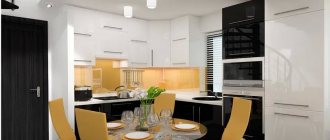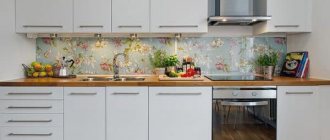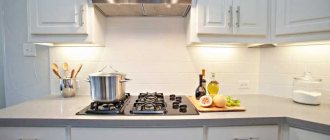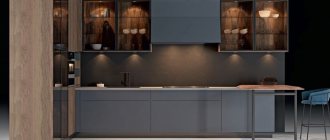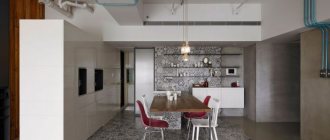No one will be surprised by the use of laminate on the floor; almost no one will be amazed by its use on the walls and even the ceiling. So why not use this universal material on a kitchen apron in this case? The popularity of this method of finishing in the kitchen is confirmed by numerous photos of design projects with this idea.
The photo shows laminate flooring in the kitchen backsplash
Laminate is not only on the floor
Laminate on the walls and as an apron in the kitchen is an original and stylish idea. But before you decide on such a bold experiment, it’s worth figuring out whether a laminate apron is really that convenient. Oddly enough, many builders call this material the best for a kitchen apron. And all because it can withstand intensive use. And if a laminate of wear resistance class 32 can withstand 10-15 years as a floor covering, then one can only imagine how long the material can serve as a wall finish.
Note! Laminate can imitate any natural structure: wood, stone, tile, granite. This opens up wide opportunities for creating unique interior solutions for wall decoration.
Photo of an original spacious kitchen with laminate finishing
Advantages of a laminate kitchen apron
- The laminated apron is easy to clean - just wipe with a damp cloth soaked in soapy water.
- High level of moisture resistance. This advantage of finishing the wall near the work area can only be felt if you buy and install a moisture-resistant laminate.
- Easy to install - much easier to install than tiles.
- Affordable cost - the decoration on the wall will last a long time, and the cost of its implementation will be less than when installing tiles.
- Large selection of colors, textures and prices.
The disadvantage of a laminate wall apron is that it cannot withstand high temperatures. Therefore, it is better to use more traditional tiles as a finish for the stove.
Photo idea for decorating an apron in the kitchen using laminate
Interesting solutions in interior design
Every housewife wants her kitchen to be the most unusual, comfortable and beautiful. Some design solutions look very nice, but are already boring.
An interesting detail in the kitchen could be an MDF apron painted with chalkboard paint. On such a panel it is very convenient to write down recipes for delicious dishes, leave reminders for the family; if there are children in the house, they will be very interested in drawing on such a surface. But, it is better to line the place in close proximity to the hob with another material, this will protect the surface from high temperatures and moisture.
7 photos
This option will look good in a loft-style kitchen; the design will be complemented by painted wooden boxes, a large table made of solid wood or a bar counter with lighting in the form of pendant spotlights.
The board apron can be decorated with several metal hooks for fabric mittens, potholders, and kitchen utensils.
Built-in shelves will help you use the apron space functionally. You can install shallow shelves in the apron above the work surface for jars of spices and kitchen knives. A long shelf with a crossbar can be decorated with small bottles of oil, vinegar or wine.
7 photos
This idea will look good in the Provence style. The panel can be veneered with light wood, as can the built-in shelves. They will accommodate glass jars with seasonings and spices, bottles of oil. You can hang small bunches of lavender and other aromatic herbs above the work surface.
The kitchen set can be painted in pastel colors: light lilac, soft blue, peach. A small painting with pastoral landscapes or drawings of wildflowers will look great. Such an interior will create a warm and cozy atmosphere.
What is laminate made of?
A laminate board has several layers:
- The base, which consists of wood fiber, is the base for the next layers and gives the board strength.
- Layers of paper impregnated with a special composition. Thanks to special impregnation, this paper forms a moisture-proof layer.
- Decorative layer - imitates different textures: wood, stone, tile. It is he who is responsible for the decorative qualities of the laminate.
- The last layer is transparent, protective. It is formed using acrylic resin with special additives.
Photo of a laconic kitchen with an equally laconic finish
Determining the height and dimensions
The standard height of a kitchen apron is 60 cm, which is convenient for people of average and tall height. However, if the majority of household members are short, then it is better to make the apron 45-55 cm high. We also recommend slightly lowering the height of the apron if the upper cabinets open upward using door closers. After all, if opening such doors is not difficult, then to close them, you will have to stand on a stool or do it in a jump.
Low apron
For a kitchen set partially or completely without wall cabinets, the apron can be designed at a standard height or an elevated one. For example, it can reach the ceiling or occupy approximately ¾ of the wall. Below are examples of aprons for kitchen sets without wall cabinets.
If desired, you can protect not only the area above the countertop and stove, but also the area behind the hood.
If the work area has a niche, then it is best to cover it completely.
See more: The correct size of the apron is the secret to a comfortable kitchen.
Choosing a laminate for an apron
Before installing it on the wall, it is important to choose the right laminate. Main criteria:
- Wear resistance class 31 or 32, no less. Such a high class is simply necessary, because during operation the apron will be exposed to various types of influences.
- Environmental safety – E1. Taking another class is dangerous, because the material will use formaldehyde, which has an impact on health. They also affect the environment.
- Moisture resistance. The material must be resistant to moisture. Naturally, such a laminate will cost more, but you don’t need much of it for an apron, so you won’t have to spend a lot.
Finishing the kitchen wall with laminate
User reviews
Sergienko Anton Pavlovich, 59 years old, Kemerovo: “I would like to compare laminate flooring with lining, which is made of larch. Polished fresh wood is much more beautiful, and if it is installed correctly, then when heated from the heat of the stove, the aroma of resin is formed. One of the disadvantages is that larch quickly turns black from water. I suffered for a long time and looked for a laminate with a specific pattern and color. I made an apron from lamellas near the sink, and from larch near the slab. Everything has been fine for four years now, there is a characteristic aroma, and the apron looks like new. In terms of money, everything cost the same as for Turkish tiles.”
Larik Nikolai Andreevich, 33 years old, Volgograd: “My advice to you is that as soon as the apron is laid, you should immediately cover it with a monolith or glass. No varnish compositions or polishes can save you from moisture. Because of the drawers, steam will not escape, and the water will hang in drops on the wall. There is neither the energy nor the time to constantly wipe and dry. It’s not for nothing that the apron was invented earlier; it’s a great phenomenon. It will be a little more expensive, but it will last for 30 years, and no less.”
Before you start
Installation of the material can be carried out in several ways: on the lathing or using the adhesive method. Regardless of the method chosen, the preparation measures for the material and surface are the same.
Installation tools
- Jigsaw or hand saw.
- Hammer.
- Building level.
- Pencil and ruler.
- Wooden block.
- Electric drill.
- Wooden slats for sheathing. If the glue method is used, then liquid nails.
- Nails, screws.
How and with what to update old furniture in the kitchen with your own hands?
Many housewives dream of new kitchen furniture. If you can’t do this yet, update the old furniture yourself. With a creative approach, this is quite possible and looks beautiful.
You can restore an old kitchen set using the decoupage technique. For this you will need decoupage napkins, PVA glue, varnish, and paint.
How to decorate old furniture using decoupage technique:
- First, you can paint the kitchen set with paint from a spray can or with a regular brush. All sides are thoroughly cleaned and wiped dry.
- When the paint is dry, glue the decoupage napkins using PVA glue. Do it quickly but carefully.
- After the glue has dried, open the walls of the headset with varnish. In total, several layers of varnish are needed, but with breaks for drying.
Now the look of an old kitchen set will no longer depress you. Using the decoupage technique, you can decorate your kitchen in Provence style.
An easier way to decorate old furniture is by gluing film or wallpaper. You need to buy a sufficient amount of film or washable wallpaper, cut it into pieces of the required area and stick it on old cabinets and doors. The kitchen will immediately look completely different.
It is not necessary to refinish the entire surface of the cabinets. You can highlight some areas that are especially in need of restoration and decorate them.
If glass is inserted into the doors, you can decorate the inside of the cabinet with film.
Many people have a leather sofa in their kitchen. Over time, it may also lose its appearance. The skin becomes dull, scratches appear, and significant damage in the form of holes may appear. You shouldn't leave your old sofa like this. By purchasing leather paint, you can breathe life into it. If there are scratches or holes, you can hide them:
- Using liquid skin.
- Using a patch to match the sofa.
- This could also be an interesting application.
Before you start gluing a piece of leather, degrease the damaged area with an alcohol-containing product.
Updating old stools and chairs is also easy:
- Wooden chairs will become as good as new if you open them with several layers of varnish.
- A stool with a wooden seat can be covered with a self-adhesive thick film.
- You can sew a fabric cover on a stool with a soft seat that will harmonize with the overall color scheme of the kitchen.
- You can also crochet or knit beautiful chair covers.
The refrigerator can be decorated with various magnets. In addition, the refrigerator can be decorated with stylish, laconic or bright stickers.
Refrigerator decor with vinyl film
Preparation for installation of the apron
Before installing the laminate to the wall, you need to prepare the material and surfaces.
The photo shows a kitchen apron made of laminate and a well-chosen countertop
Material
As soon as the laminate gets into the house, it cannot be used immediately; you need to give it some time to get used to the conditions in the room. It is optimal to keep the material for no more than 48 hours in the room where it will be installed. This is necessary to achieve the correct temperature and humidity in order to minimize deformation of the coating after its installation.
These conditions for laminate flooring for this functional area must be observed, since in the section of the wall, which is called the apron, the temperature will in any case be higher than in the rest of the rooms.
Wall
While the laminate is curing, you can carry out preparatory work on the wall. Before installation, you need to remove furniture from the wall.
Photo of a finished kitchen apron made of laminate
Next, the old finish, if any, is removed from the wall and cleaned of dust. You also need to level the section of the wall. This can be done using putty. The main thing is that the surface for installation is flat. Be sure to check the evenness using a building level.
Care Tips
After installation, the laminate is cleaned of debris and dirt. It is enough to rinse it with plain water. Detergents are used to remove grease and dirt during operation.
If scratches appear, you can use a wax pencil that matches the color of the coating - apply it to the damaged area and polish with a dry cloth. Damage from water can be restored by wax itself - if applied to the entire surface, it will create a protective film.
Deep scratches are repaired with a special putty for laminate flooring, which is sold in powder form in hardware stores. To get rid of damage:
- Dilute the powder according to the instructions.
- Clean the surface from dirt.
- Apply the product using a spatula, being careful not to go beyond the scratch. If this happens, the excess must be removed as quickly as possible before the putty dries.
- After drying (half an hour to an hour), the surface is polished with a dry cloth.
Installation on the lathing
The lathing installation method is convenient for such material; it does not require careful leveling and sealing of cracks and defects on the wall. It is important to maintain the level of the sheathing when installing the bars - this will ensure the geometry of fastening the panels.
Photo of adhesive installation on the sheathing
It is convenient to make the lathing from wooden blocks - they are attached directly to the wall using dowels. The location of the sheathing is perpendicular to the orientation of the canvases. The distance between adjacent beams is 30 cm.
After installing the sheathing, you can begin attaching the laminate panels. To make it easier to set the level, you need to screw a support block along the lower edge of the apron; you can also use a drywall profile for this.
The laminate is mounted to the bars using small nails in the place where the lock protrudes. Panels of material are fastened together using special glue or their own locking mechanism.
This method is not very convenient because it steals useful kitchen space. Since the sheathing takes up at least 3–4 cm.
Grouting joints
The choice of grout should be done in the same way as with glue. We take the most popular and affordable option. Fortunately, the stores are full of them. The mixture is a mixture of varied composition and shade. You will also need a regular sponge, for example, for washing a car.
We choose a rubber spatula as our main assistant. It does not scratch or otherwise mechanically damage the top layer of ceramics, which is varnished and its appearance and functions depend on this. A small spatula will fit perfectly when grouting internal corners.
It is better to get rid of the remaining grout within 15 minutes, otherwise it will harden and the process will be considerably delayed. After this, all ceramic tiles should be carefully and thoroughly washed more than once until the stains completely disappear.
Installation without sheathing
In this case, the sheets will be attached directly to the wall. This option is only suitable for perfectly smooth walls. They allow a level difference of no more than 3 mm, the same as when laying material on the floor. Such evenness can be achieved by first leveling the walls with plasterboard. With the help of plaster, such evenness can also be achieved, but it will not be easy.
The photo shows a finished apron, mounted without sheathing
Note! To glue laminate panels, you should use silicone rather than liquid nails. It has similar adhesive properties, but the structure is more fluid, due to this the material can be pressed as close as possible to the wall, without the formation of tubercles and irregularities. This can happen with liquid nails.
The photo shows an organic combination of laminate on the apron and kitchen furniture.
The method is considered more labor-intensive, but the result is worth it. In this way, it will be possible to avoid the disadvantage of the installation option with lathing, when part of the space is stolen.
Mounting sequence:
- Prepare the surface for gluing.
- Install a stop - similar to the previous method, it can be a wooden block or a plasterboard profile.
- Apply adhesive to the back of the panel.
- Press it firmly against the wall and hold it a little so that the composition “seizes.”
- Install all other panels using this method.
Photo idea of installing laminate flooring on the wall in the kitchen
. Some important points:
- Glue must also be applied to the end.
- If cracks form after drying, it is necessary to coat them with the same adhesive composition.
- After attaching the first row, you need to wait 2-3 hours until the adhesive composition dries - this will make it a reliable support for subsequent rows.
Caring for a laminated coating is no more difficult than caring for a regular kitchen apron.
Type of laminate with a chamfer when finishing an apron
Required Tools
tool for laying laminate on an apron
To carry out the work, you will need tools that are available to almost any home owner:
- roulette,
- level,
- ruler,
- putty knife,
- screws and nails,
- glue,
- hammer,
- screwdriver,
- electric drill,
- jigsaw
Advantages and disadvantages of design
Wood paneling is a stylish and timeless option. It is appropriate in any interior decoration, looks elegant and harmonious, and is combined with other finishing materials. Natural wood is difficult to maintain. If cleaning wallpaper is limited to wiping with a damp cloth during general cleaning, then wooden walls are polished every day. Therefore, instead of wallpaper and natural wood, a laminate or a laminate that imitates rare and valuable types of wood is chosen for wall decoration.
Advantages of using laminate:
- looks like natural wood;
- durable and wear-resistant material due to the fact that it consists of several layers;
- not afraid of mechanical impact;
- abrasion resistant;
- service life averages a quarter of a century;
- the planks and modules have ideal geometric shapes and precise dimensions, so after easy installation they create a single piece;
- does not require painstaking and daily care;
- costs less than lining or parquet.
Laminate coatings have a drawback: they do not withstand prolonged exposure to moisture. Therefore, they are not suitable for finishing balconies, basements and baths. For this reason, the kitchen apron area is a bad place to install panels, but there are moisture-resistant varieties that can be installed in any room.

